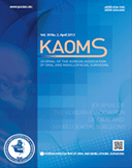Journal of the Korean Association of Oral and Maxillofacial Surgeons
- P-ISSN2234-7550
- E-ISSN2234-5930
- SCOPUS, KCI, ESCI
 ISSN : 2234-7550
ISSN : 2234-7550
Complications after craniofacial reconstruction with calcium phosphate cements: a case report and review of the literature
Noorahmad Latifi (Department of Plastic and Reconstructive Surgery, Hazrate Fatemeh Hospital, School of Medicine, Iran University of Medical Sciences)
Fatemeh Latifi (Department of Oral and Maxillofacial Surgery, Taleghani Hospital, School of Dentistry, Shahid Beheshti University of Medical Sciences)
Abstract
Among different graft materials for craniofacial reconstruction, calcium phosphate cements have the advantages of alloplastic grafts and wide use. The authors report a case of foreign body reaction following frontal reconstruction with JectOS (an injectable calcium orthophosphate cement; Kasios) and reviewed the literature on complications of this material after craniofacial reconstruction from 2002 to 2017. Complications were categorized into two groups: immunologic reactions (consisting of seroma collection, chronic sinus mucosa swelling, and foreign body reaction) and non-immune events (infection, fragmentation, and ejection). It is wise to use calcium phosphate-based material only in selected cases with small defects, and long-term follow-up is needed to observe their consequences.
- keywords
- Calcium phosphate cements, Craniofacial reconstruction, JectOS, Complication
- 48Downloaded
- 159Viewed
- 0KCI Citations
- 0WOS Citations